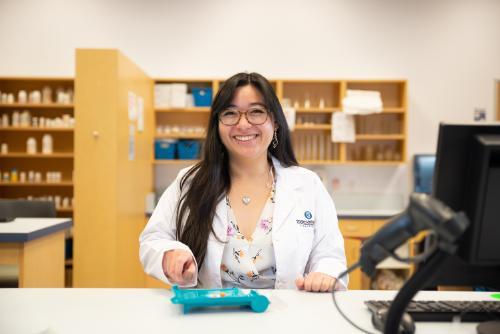How to Become a Pharmacist: Education, Job Description & Salary
In-Depth Guide to Everything You Need to Know to Become a Pharmacist

Are you ready to embark on a rewarding and fulfilling career path that combines healthcare, science, and leadership? Becoming a pharmacist might be the perfect choice for you.
In this comprehensive guide on how to become a pharmacist, we will walk you through the steps to become a pharmacist, from education and licensure to finding the right career path and staying up-to-date in this ever-evolving field.
Short Summary
- Pathway to becoming a pharmacist typically requires completion of undergraduate coursework in related fields such as biology, chemistry, physics and math.
- Licensure and certifications are required to practice pharmacy. NAPLEX & CPJE Exams must be passed for state licensure.
- Pharmacy is a highly sought after profession with a strong job outlook & six figure median salary. Continuing education & professional development necessary for optimal care provision.
Pharmacy Education Pathway
The journey to becoming a pharmacist begins with the right education. As an aspiring pharmacist, you must complete coursework in areas such as biology, chemistry, physiology, and math, typically in 2-3 years. A bachelor’s degree is not required.
Some high school students, who are prospective students for colleges and universities, can even gain an early advantage by taking Advanced Placement classes in these subjects.
Undergraduate Coursework
Once you have decided to pursue a career in pharmacy, it is essential to complete your undergraduate coursework, which generally takes 2-3 years. During this time, you will study subjects such as chemistry, anatomy, biology, mathematics, statistics, and microbiology, all of which are crucial components of a pharmacy degree.
These courses will provide you with a strong foundation in the sciences and prepare you for the rigorous pharmacy school curriculum that awaits you.
Choosing a Pharmacy School

After completing your coursework, the next step is to choose a pharmacy school. It is crucial to consider factors such as accreditation, cost, location, and curriculum when selecting a school. Additionally, visiting campuses and comparing programs can help you find the best fit for your needs, as most pharmacy schools have their own unique offerings.
Pharmacy School Experience
Pharmacy school typically takes three to four years to complete, during which you will engage in a combination of coursework, clinical rotations, and residencies. This experience will immerse you in various aspects of pharmacy practice, from learning about drug interactions and medication management to developing patient care skills.
The hands-on experiences gained during pharmacy school will be invaluable in your future career as a pharmacist.
Licensure and Certification
To become a licensed pharmacist, you must pass two pharmacist licensure exams and fulfill the pharmacist licensure requirements established by the state in which you will practice. Obtaining licensure and optional certifications in specialized areas is crucial for ensuring your competency and expertise in the field of pharmacy. To become a pharmacist, dedication and commitment to your studies and professional development are essential.
These certifications demonstrate your knowledge and skills in areas such as pharmacology, drug therapy, and more.
NAPLEX and MPJE/CPJE Exams
The NAPLEX (North American Pharmacist Licensure Examination) and MPJE (Multistate Pharmacy Jurisprudence Examination) are two essential exams for obtaining a license to practice pharmacy. The NAPLEX evaluates your understanding of pharmacy practice, while the MPJE assesses your knowledge of federal and state-specific pharmacy laws (California has its own law exam, the CPJE).
Passing these exams demonstrates your readiness to provide safe and effective pharmaceutical care to patients.
State Licensure
Obtaining state licensure after passing the NAPLEX and MPJE/CPJE exams is the final step in becoming a pharmacist. State licensure requirements may vary, but generally include possessing a PharmD degree, passing the NAPLEX and MPJE/CPJE exams, and fulfilling any other requirements specified by the state board of pharmacy.
Once licensed, you will be able to practice pharmacy and provide essential healthcare services to your community.
Optional Certifications
In addition to licensure, pharmacists may choose to pursue optional certifications in specialized areas such as critical care, pediatrics, psychiatric pharmacy, oncology, nutrition, and infectious disease. These certifications allow you to further develop your expertise and distinguish yourself in the field of pharmacy, ultimately leading to improved patient care and potential career advancement opportunities.
By obtaining certifications, pharmacists can demonstrate their commitment to the profession and their dedication to providing quality care.
Pharmacy Career Paths
Once you have completed your education and obtained licensure, you can explore various pharmacy career paths, including retail pharmacy, hospital pharmacy, and many non-traditional pharmacy roles.
Each career path offers unique work environments and responsibilities, allowing you to find the perfect fit for your interests and skills.
Community Pharmacy
Community pharmacy involves working in community/retail pharmacies, dispensing medications, and counseling patients on proper medication use. Many community pharmacists are also involved in providing vaccinations and helping monitor patients’ blood sugar and blood pressure. This career path allows you to interact directly with patients and play an important role in ensuring their health and well-being.
In a community pharmacy setting you may also be responsible for managing inventory, processing insurance claims, and collaborating with other healthcare professionals to optimize patient care. Some pharmacists work for large chain pharmacy employers, some work for smaller independent pharmacies, and some own their own pharmacy.
Hospital Pharmacy
Hospital pharmacy focuses on medication management within hospital settings, collaborating with healthcare teams to optimize patient care. In this role, you will be responsible for dispensing medications, communicating with healthcare providers, managing potential drug interactions, and ensuring patients receive the correct medication and dosage in a timely manner.
Hospital pharmacists may also be involved in clinical trial management and quality improvement initiatives. Pharmacists with additional training, such as a residency or a fellowship, are often involved in managing the medications of the patients, working closely as part of the healthcare team to optimize the care of all patients in their hospital.
Specialty Pharmacy

Specialty pharmacy involves working in specialized areas such as oncology, nuclear pharmacy, or specialty medications, providing expert knowledge and care in specific fields. This career path allows you to focus on a particular area of interest and develop a deep understanding of the unique challenges and opportunities within that specialty.
Ambulatory Care is an important part of the pharmacy profession, where pharmacists who have advanced training (such as a residency or a fellowship), work in medical clinics to help manage patients’ medications, avoid or treat side effects, and help patients improve their ability to take their medications on their own.
With specialized knowledge and skills, you can provide exceptional care to patients with complex medical conditions.
Pharmacy Job Outlook and Salary
The pharmacy job outlook and salary expectations show strong demand for pharmacists, with six-figure median salaries and various work settings available. This rewarding career path offers opportunities for growth and advancement, as well as the chance to make a meaningful difference in the lives of patients.
Pharmacists are in high demand, and the job outlook is positive. With a median salary of $128,710. (https://www.bls.gov/ooh/healthcare/pharmacists.htm)
Job Outlook
There is growth for Pharmacy careers, with an estimated 7,700 job openings projected from 2021 to 2031. Additionally, normal turn-over in pharmacists (such as those retiring or moving into management) call for around 13,600 new pharmacists each year. The demand for pharmacists is expected to increase across a multitude of healthcare settings, including hospitals and clinics, due to the growing complexity of medication therapy and the need for accurate drug selection, dosing, monitoring, and management.
Pharmacists are expected to play an increasingly important role in the healthcare system, providing patient-centered care alongside pharmacy technicians, also known as pharmacy tech professionals.
Salary Expectations
Salary expectations for pharmacists vary depending on factors such as geographical area, work environment, and years of experience. The median annual salary for pharmacists in the United States is $128,710.
Factors such as location, experience level, and the particular workplace in which they are employed can all influence a pharmacist’s salary.
Continuing Education and Professional Development
Continuing education and professional development are essential for pharmacists to maintain licensure and stay current in the field. By participating in ongoing learning opportunities, you can ensure you are providing the highest level of care to your patients.
These opportunities can include attending conferences, taking courses, and participating in webinars.
State Requirements
State requirements for continuing education vary, but typically include topics such as drug law and patient safety, with specific credit hours needed to maintain licensure.
Staying up-to-date on these requirements is crucial for maintaining your pharmacist license and ensuring you are providing the best possible care to your patients.
Professional Organizations and Resources
Professional organizations and resources, such as the American Pharmacists Association and the American Society of Health-System Pharmacists, provide support and opportunities for networking and professional development. By joining these organizations, and/or their state-level affiliates, and taking advantage of their resources you can continue to grow and develop professionally, ultimately enhancing your career and the care you provide to patients.
These organizations offer a variety of resources, such as continuing education courses, conferences, and publications.
Summary
In conclusion, becoming a pharmacist is a rewarding and fulfilling career path that combines healthcare, science, and patient care. From the necessary education and licensure to the various career paths and continuing education opportunities, this comprehensive guide has provided you with the information you need to pursue your dream of becoming a pharmacist. With dedication, hard work, and a passion for helping others, you can make a meaningful difference in the lives of patients and contribute to the ever-evolving field of pharmacy.
Frequently Asked Questions
What is the shortest time to become a pharmacist?
It typically takes four years to become a pharmacist, but accelerated programs may allow students to finish in three years.
How many years does it take to become a pharmacist in California?
Through accelerated programs a PharmD degree can be completed in 3 years in addition to all prerequisites.
What are the steps to becoming a pharmacist?
Becoming a pharmacist requires completing undergraduate coursework, selecting a pharmacy school, gaining hands-on experience during pharmacy school, passing the NAPLEX and MPJE/CPJE exams, and obtaining state licensure.
Each of these steps requires dedication and hard work. Undergraduate coursework should include classes in biology, chemistry, and other sciences. Selecting a pharmacy school requires researching the school’s curriculum, faculty, and accreditation. During pharmacy school, students should gain hands-on experience through internships and rotations.
